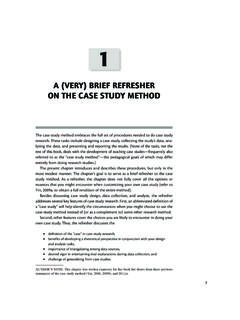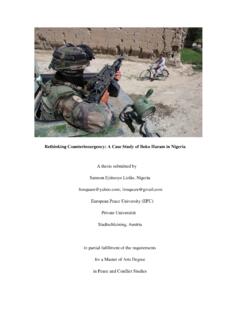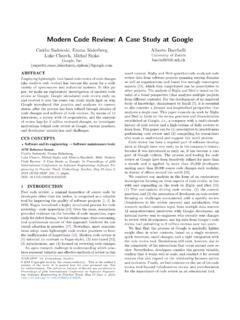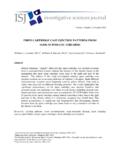Transcription of CASE STUDY - Continuity Central
1 Business Continuity Journal, Volume Two, Issue Three Page 18 case STUDY : THE GLASGOW AIRPORT ATTACK FROM A BUSINESS Continuity AND CRISIS MANAGEMENT POINT OF VIEW Abstract: Glasgow Airport is owned and operated by BAA Ltd. Handling over 8. 8 million passengers a year; it is the busiest of the three BAA-owned Scottish Airports. Glasgow is situated in the west of Scotland with the airport some 7 miles to the west of the city centre near to the town of Paisley. On 30 June 2007, the second busiest day of the year due to the school holidays commencing the previous day, Glasgow Airport became the target for a car bomb attack, which propelled the airport into the glare of the world s media and created severe business Continuity issues for the airport.
2 In line with BAA group requirements, Glasgow Airport has a fully functioning business Continuity management (BCM) strategy. This came into its own during the incident and this case STUDY details the attack and its repercussions, overviews the response and highlights the lessons learned. Author: Gillies Crichton, ABCI, is currently head of compliance at BAA Glasgow Airport which incorporates safety, environment, business Continuity , risk management and emergency planning. He previously spent 17 years within the BAA Airport Rescue and Firefighting Service in Scotland with seven years as the Senior Airport Fire Officer at Glasgow Airport and nine years within the Retained Fire Service in Lothian and Borders Fire and Rescue Service.
3 He has a great deal of experience in setting up and running crisis management and business recovery teams. Business Continuity Journal, Volume Two, Issue Three Page 19 The incident At 15:11 hours on Saturday 30 June 2007, a Jeep Cherokee 4x4 vehicle gained unauthorised access to the inner forecourt of Glasgow Airport. The vehicle manoeuvred in an attempt a run directly at door two of the main terminal building and to gain entry into the main check-in area of the terminal building. Flames were seen issuing from the vehicle and onto the front of the building and the canopy above the doors.
4 The terminal fire alarm was activated and an evacuation of the building took place. This was, in the main, a calm and controlled evacuation, initially of the zone in which the call point was activated. As smoke permeated through the building, various smoke detectors activated and additional areas of the building were evacuated. The well managed evacuation of an extremely busy terminal was testament to well trained staff and robust evacuation plans which are regularly tested. As the incident unfolded, eyewitnesses stated that two males exited from the car, with the driver on fire.
5 The individuals were wrestled to the ground by police officers, assisted by members of the public and airport staff who were in the vicinity. Both suspects were arrested at the scene. Many members of the public, who were in the area, caught the scene on video, camera and camera phones. The pictures of the immediate aftermath of the incident were quickly beamed around the world. The response The initial attack on the fire was made by Strathclyde Fire and Rescue using hose lines. On the arrival of the BAA Airport Rescue & Firefighting (ARFF) unit, a high output foam monitor was utilised and the fire brought under control very quickly.
6 The fires were under control within 15 minutes and all fires were extinguished within 30 minutes of the initial explosion. After this, cooling of the entire area continued. At the height of the initial response, there were 25 pumping appliances under the command of the Chief Fire officer, plus specialist appliances from Strathclyde Fire and Rescue and three major foam tenders, one light foam tender and command vehicles from the ARFF unit. The airport s integrated emergency plans include a support mechanism whereby off duty persons are called in to support the front line staff.
7 This is in the form of a crisis management team who look after the tactical command and a business recovery team who look after the strategic command on behalf of the airport. The crisis team was initiated and operational within 45 minutes with a business recovery team operational an hour later. Business Continuity Journal, Volume Two, Issue Three Page 20 Business recovery team The business recovery team initially established the critical success factors. These were broken down into short, medium and long term.
8 No single business recovery plan exists for this type of incident as the entire incident was complex with a large number of stakeholders involved. The main business Continuity plans were utilised for short term loss of the terminal building and loss of road infrastructure. The latter was of particular use as traffic was initially banned from the forecourt area of the airport. In order to get a limited operation up and running, it was important to build on our well-established relationship with Strathclyde Police.
9 The whole terminal forecourt area was clearly being treated as a crime scene which restricted movement in and around the area and, therefore, stopped the business recovery team getting access to the building. Through consultation and flexible working, the police were able to concentrate on the incident area which gave us access to the terminal building, in the first instance through the adjoining multi storey car park, and then through the ground floor doors. On getting initial access, we were able to utilise T2 (a separate overflow check-in area).
10 This meant we were able to work ahead of the police to be operationally ready when the area was handed over. Strategy Our BCM strategy served us well on the day of the incident. We currently have a Performance Standard provided at a BAA Group level which states what is required for each business unit to ensure compliance. This non-prescriptive standard, allows us to put in place workable policies, procedures and solutions at a local level which is reflective of the particular business unit s needs.















